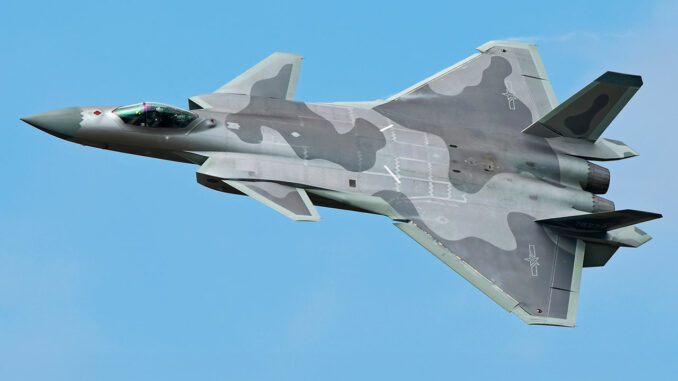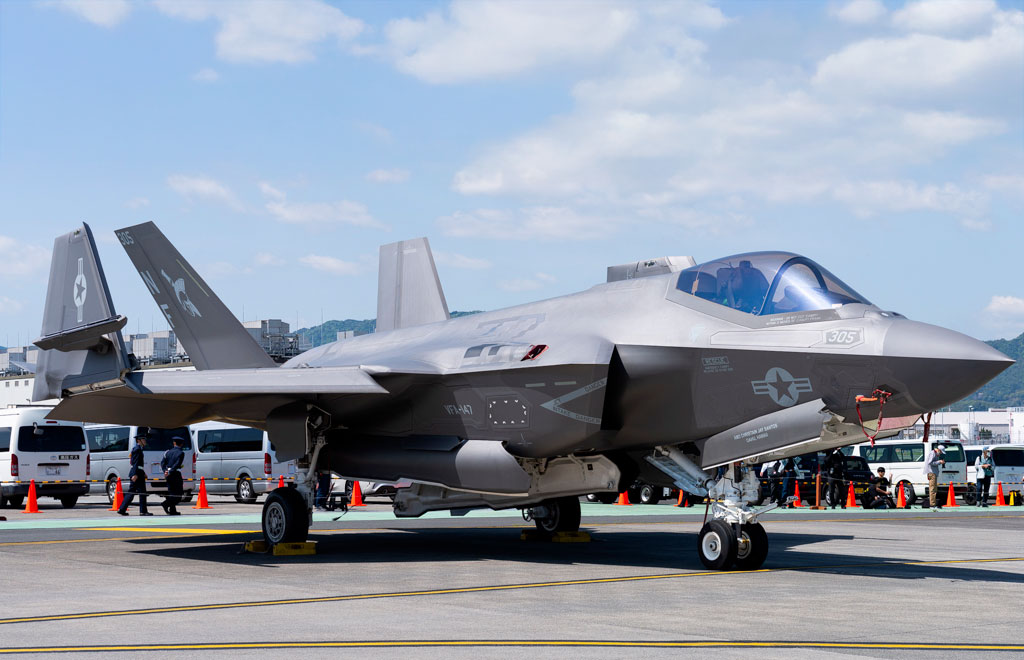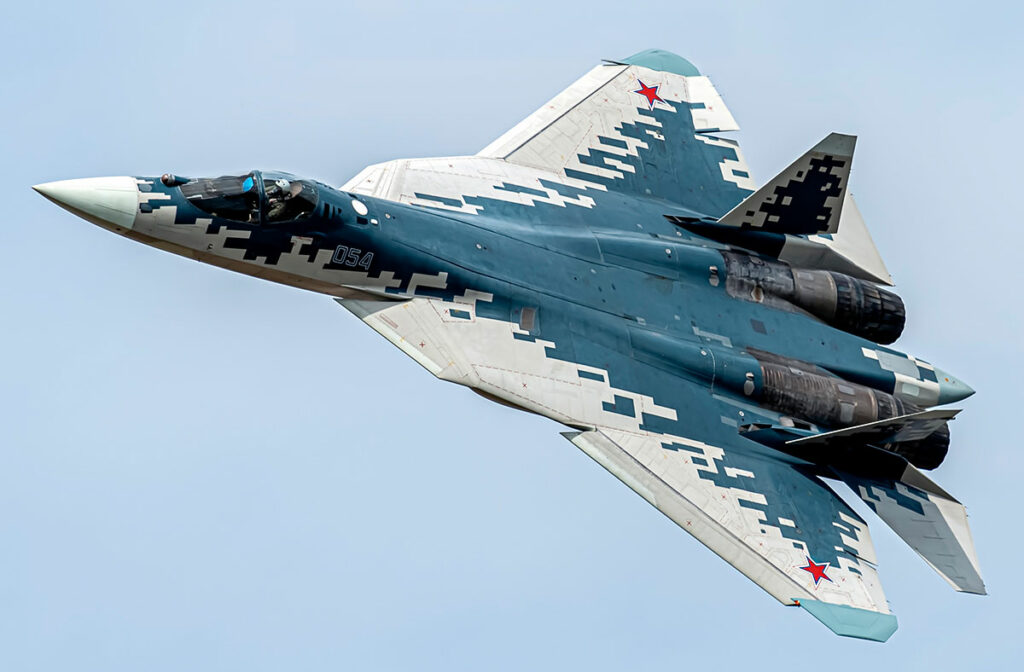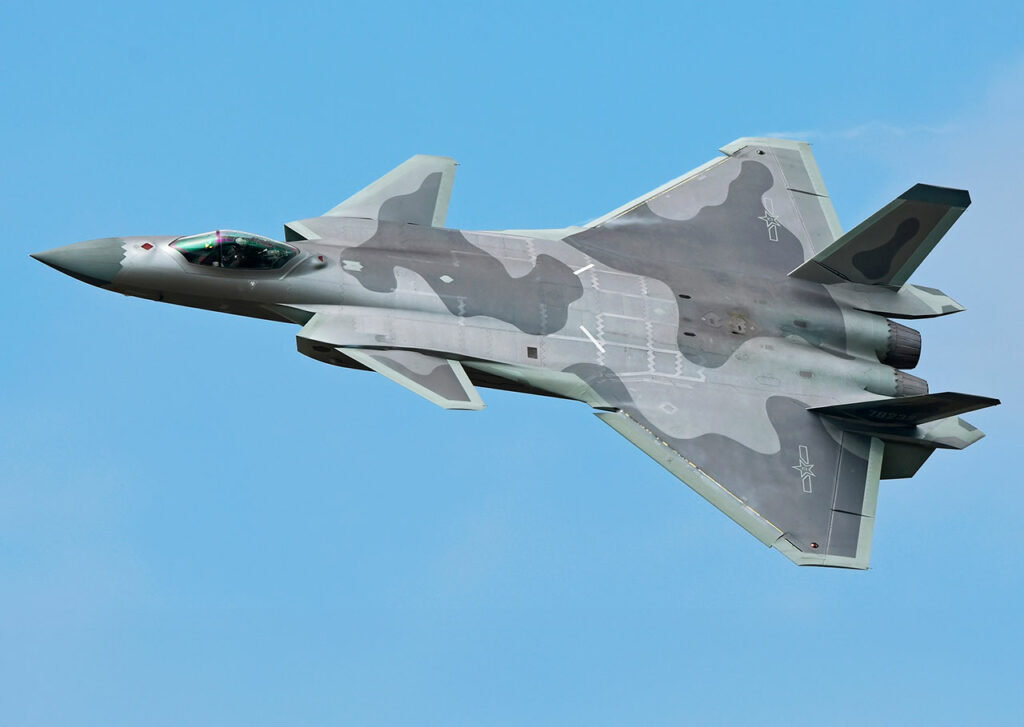
Detailed analysis of the weapon systems integrated into fifth-generation fighter jets, with a focus on the F-35, Su-57, and J-20.
The weaponry of the Lockheed Martin F-35 Lightning II
The F-35 Lightning II is a 5th generation fighter aircraft designed around the principles of stealth, sensor fusion and versatility. Three variants exist: F-35A (conventional), F-35B (short takeoff/vertical landing) and F-35C (carrier-based). Each version shares an internal weapons bay, which is essential for limiting the radar cross section. The internal compartment can carry up to 2.6 tons of weapons, with the option of switching to “Beast Mode,” which allows it to carry up to 8.2 tons of external weapons, at the expense of stealth. The weapon system architecture is based on centralized avionics compatible with many types of Western munitions.

Air-to-air missiles
The F-35 carries two AIM-120D AMRAAM missiles with active radar guidance and extended range (>160 km) in its internal bays as standard. For close combat, it uses the AIM-9X Block II missile, with infrared homing and thrust vectoring, launched from a stealthy external rail or via side bays depending on the variant. Tests are underway to integrate the European Meteor, which has a range of approximately 200 km.
Air-to-ground missiles
The aircraft is capable of launching several types of guided munitions. It can use 900 kg GBU-31 JDAM bombs (GPS/INS guidance), 225 kg GBU-12 bombs (laser guidance), and 110 kg GBU-39 SDB (Small Diameter Bombs), enabling multiple attacks on dispersed targets. It can also carry AGM-158 JASSM cruise missiles with penetrating warheads, with a range of 370 to 925 km depending on the version.
Internal cannon
Only the F-35A has an internal cannon: the GAU-22/A with four 25 mm barrels, capable of firing 3,300 rounds per minute. It is mounted in the left wing with a concealed hatch to maintain the stealth profile. The B and C versions carry an external pod.
Future capabilities
The Block 4 standard currently being deployed provides compatibility with HAWC or Mako hypersonic missiles, reaching Mach 5 to Mach 7. Other developments include the integration of B61-12 tactical nuclear bombs, planned for the US arsenal and certain allies. Ongoing modernization ensures interoperability with the US, NATO, and strategic partner air forces.

Armament of the Sukhoi Su-57 Felon
The Sukhoi Su-57, designated Felon by NATO, is the first fifth-generation fighter aircraft developed by Russia. It was designed to combine stealth, extreme maneuverability, and operational versatility. The aircraft features a 25% composite airframe, semi-swept air intakes, and internal weapon bays. It can carry approximately 10 tons of weapons, including 2.5 tons in stealth configuration. Integrated targeting systems, such as the IRST 101KS-V, enable long-range passive targeting, complementing its weapon architecture.
Air-to-air missiles
The Su-57 carries up to six R-77M (RVV-SD) missiles with active radar guidance and an estimated range of 200 km in its ventral bays. This missile is the successor to the original R-77 and is designed for BVR (beyond visual range) combat. For dogfighting, the Felon uses the K-74M2, a modified version of the R-73, which can be housed in side bays. Its range is estimated at 40 to 50 km, with all-aspect infrared guidance capability.
Air-to-ground missiles
The Su-57 is also designed for ground attack. It is compatible with the Kh-59MK2 cruise missile, which is stealthy, has a range of 290 km and a 320 kg warhead. It can also carry the Kh-31AD, a supersonic missile for destroying radars or naval targets, reaching Mach 3.5 over a range of up to 250 km.
KAB-250 and KAB-500 guided bombs complete the offensive payload, weighing between 250 kg and 500 kg, with laser or GLONASS guidance.
Internal cannon
The Su-57 has a 30 mm GSh-30-1 cannon integrated into the right side, capable of firing 1,800 rounds per minute with a useful capacity of 150 shells. It is partially concealed under a movable hatch to preserve the radar profile. This cannon, used on the Su-27 and MiG-29, remains reliable but imposes vibration constraints on the airframe.
Planned developments
The Su-57 is to be gradually equipped with Kh-69 hypersonic missiles, capable of striking targets over 700 km away at speeds close to Mach 5. There are also plans to integrate directed (laser) weapons into future versions. Russia is developing a two-seater version (Su-57UB) and an unmanned version to expand the aircraft’s missions.

The Chengdu J-20 Mighty Dragon’s weaponry
The Chengdu J-20, nicknamed Mighty Dragon, is the fifth-generation fighter jet designed by the People’s Republic of China. It is being developed by the Chengdu Aircraft Industry Group under the supervision of AVIC. The aircraft was designed to operate at long ranges in contested environments, with an emphasis on stealth, autonomy, and air superiority. The J-20 has two main internal bays under the fuselage and two side bays dedicated to short-range missiles. It can carry approximately 8 tons of weapons, much of which is stored in the cargo bay to limit its radar signature. Its doctrine favors long-range attacks before the enemy can respond effectively.
Air-to-air missiles
The J-20’s main weapon is the PL-15, an active radar-guided BVR air-to-air missile. This missile is estimated to be capable of striking targets at ranges of over 200 km, and some Chinese sources even claim a range of over 300 km thanks to a ramjet engine. It represents a serious competitor to the American AMRAAM. The J-20 also carries the PL-10, a short-range infrared missile housed in the side bays. This missile, comparable to the European IRIS-T or AIM-9X missiles, has an infrared imaging seeker and a vector thrust system allowing extreme angles of engagement. It is optimized for close combat, although the J-20 is primarily designed to avoid it.
Air-to-ground missiles
Although the J-20’s primary mission is air superiority, it retains a secondary ground attack capability. It can carry LS-6 gliding bombs, weighing between 50 and 500 kg, in a modular GPS/INS-guided version. These bombs, similar to the American JDAMs, allow precision strikes without compromising stealth. The J-20 could also be compatible with the YJ-91 air-to-ground missile, a copy of the Russian Kh-31, but this capability remains to be confirmed.
No internal cannon
Unlike the F-35A or the Su-57, the J-20 has no internal cannon. This technical choice is the result of a Chinese strategic approach that favors long-range engagements and weight savings. Dogfighting is considered obsolete by Chinese planners, who are focusing on long-range firing via hypersonic vectors or smart missiles. However, this absence limits the J-20’s ability to engage an opponent in close combat if the firing range is reduced.
Comparison and outlook
The weapon systems of fifth-generation fighter jets reveal marked doctrinal differences between the United States, Russia, and China. Each aircraft was designed according to national strategic priorities, which are reflected in their payload capacity, the nature of their integrated munitions, and their intended operational profile.
The F-35 Lightning II, particularly in its A version, stands out for its joint versatility: air-to-air, air-to-ground, electronic warfare, tactical nuclear strike, and close support capabilities, while maintaining a good level of stealth in its standard configuration. It is capable of alternating between stealth and massive firepower depending on the threat. Its compatibility with a wide range of NATO munitions, its digital maintenance via ALIS (replaced by ODIN), and its allied logistics network further enhance its appeal.
Conversely, the Sukhoi Su-57 Felon reflects Russian doctrine: priority is given to maneuverability, supercruise, and multispectral strike, even at the expense of stealth that is more rudimentary than that of the F-35 or J-20. The emphasis is on the diversity of its arsenal—hypersonic missiles in development, anti-radar weapons, and high-payload guided bombs. Strategic autonomy is a priority: the Su-57 can operate without intensive support from external sensors. However, it remains hampered by low production rates and a limited export network.
Finally, the Chengdu J-20 Mighty Dragon reflects a Chinese doctrine focused on long-range air superiority, with little interest in close combat or tactical support. The absence of an internal cannon, the two-seat design intended for drone coordination (loyal wingman), and the integration of very long-range missiles indicate a desire to impose distance, particularly against enemy refueling aircraft or AWACS. However, its armament remains limited by doubts about the reliability of its WS-10C engines and a lack of modularity with regard to foreign munitions.
Commercially, the F-35 dominates the market, with more than 980 units delivered to 17 countries. To date, the Su-57 has only been exported in confidential quantities, mainly to close political partners. The J-20, meanwhile, is not available for export, consolidating its strictly domestic role.
These disparities illustrate a geopolitics of armament in which a fighter jet platform cannot be separated from its onboard arsenal, targeting interfaces, and the command network into which it is integrated. In this sense, the armament of fifth-generation fighter jets is not just a catalog of missiles: it is a concrete projection of a state’s military ambitions.
War Wings Daily is an independant magazine.